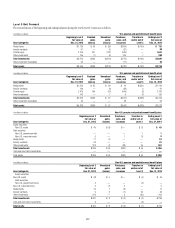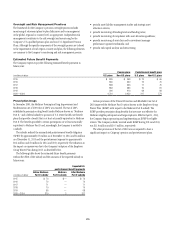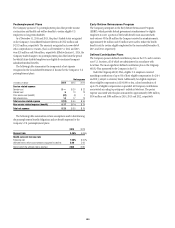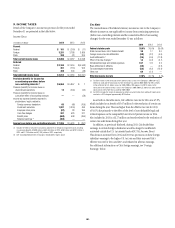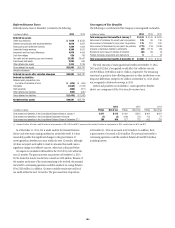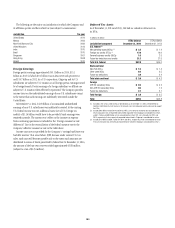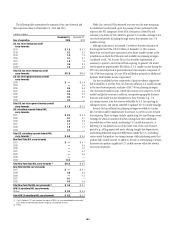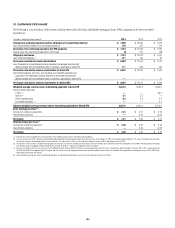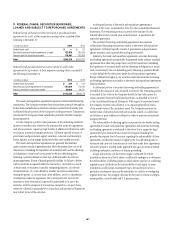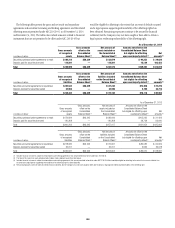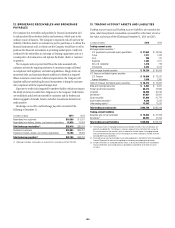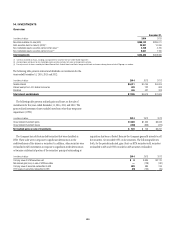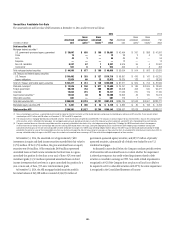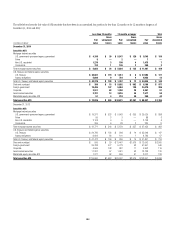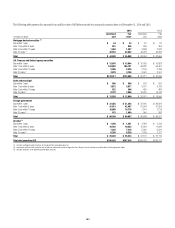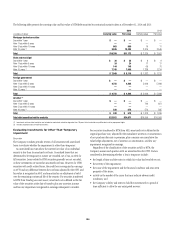Citibank 2014 Annual Report Download - page 204
Download and view the complete annual report
Please find page 204 of the 2014 Citibank annual report below. You can navigate through the pages in the report by either clicking on the pages listed below, or by using the keyword search tool below to find specific information within the annual report.
187
11. FEDERAL FUNDS, SECURITIES BORROWED,
LOANED AND SUBJECT TO REPURCHASE AGREEMENTS
Federal funds sold and securities borrowed or purchased under
agreements to resell, at their respective carrying values, consisted of the
following at December 31:
In millions of dollars 2014 2013
Federal funds sold $ — $ 20
Securities purchased under agreements to resell 123,979 136,649
Deposits paid for securities borrowed 118,591 120,368
Total $242,570 $257,037
Federal funds purchased and securities loaned or sold under
agreements to repurchase, at their respective carrying values, consisted of
the following at December 31:
In millions of dollars 2014 2013
Federal funds purchased $ 334 $ 910
Securities sold under agreements to repurchase 147,204 175,691
Deposits received for securities loaned 25,900 26,911
Total $173,438 $203,512
The resale and repurchase agreements represent collateralized financing
transactions. The Company executes these transactions primarily through its
broker-dealer subsidiaries to facilitate customer matched-book activity and
to efficiently fund a portion of the Company’s trading inventory. Transactions
executed by the Company’s bank subsidiaries primarily facilitate customer
financing activity.
It is the Company’s policy to take possession of the underlying collateral,
monitor its market value relative to the amounts due under the agreements
and, when necessary, require prompt transfer of additional collateral in order
to maintain contractual margin protection. Collateral typically consists of
government and government-agency securities, corporate and municipal
bonds, equities, and mortgage-backed and other asset-backed securities.
The resale and repurchase agreements are generally documented
under industry standard agreements that allow the prompt close-out of all
transactions (including the liquidation of securities held) and the offsetting
of obligations to return cash or securities by the non-defaulting party,
following a payment default or other type of default under the relevant
master agreement. Events of default generally include (i) failure to deliver
cash or securities as required under the transaction, (ii) failure to provide
or return cash or securities as used for margining purposes, (iii) breach
of representation, (iv) cross-default to another transaction entered into
among the parties, or, in some cases, their affiliates, and (v) a repudiation
of obligations under the agreement. The counterparty that receives the
securities in these transactions is generally unrestricted in its use of the
securities, with the exception of transactions executed on a tri-party basis,
where the collateral is maintained by a custodian and operational limitations
may restrict its use of the securities.
A substantial portion of the resale and repurchase agreements is
recorded at fair value, as described in Note 25 to the Consolidated Financial
Statements. The remaining portion is carried at the amount of cash
initially advanced or received, plus accrued interest, as specified in the
respective agreements.
The securities borrowing and lending agreements also represent
collateralized financing transactions similar to the resale and repurchase
agreements. Collateral typically consists of government and government-
agency securities and corporate debt and equity securities.
Similar to the resale and repurchase agreements, securities borrowing
and lending agreements are generally documented under industry standard
agreements that allow the prompt close-out of all transactions (including
the liquidation of securities held) and the offsetting of obligations to return
cash or securities by the non-defaulting party, following a payment default
or other default by the other party under the relevant master agreement.
Events of default and rights to use securities under the securities borrowing
and lending agreements are similar to the resale and repurchase agreements
referenced above.
A substantial portion of securities borrowing and lending agreements is
recorded at the amount of cash advanced or received. The remaining portion
is recorded at fair value as the Company elected the fair value option for
certain securities borrowed and loaned portfolios, as described in Note 26
to the Consolidated Financial Statements. With respect to securities loaned,
the Company receives cash collateral in an amount generally in excess
of the market value of the securities loaned. The Company monitors the
market value of securities borrowed and securities loaned on a daily basis
and obtains or posts additional collateral in order to maintain contractual
margin protection.
The enforceability of offsetting rights incorporated in the master netting
agreements for resale and repurchase agreements and securities borrowing
and lending agreements is evidenced to the extent that a supportive legal
opinion has been obtained from counsel of recognized standing that
provides the requisite level of certainty regarding the enforceability of these
agreements, and that the exercise of rights by the non-defaulting party to
terminate and close-out transactions on a net basis under these agreements
will not be stayed or avoided under applicable law upon an event of default
including bankruptcy, insolvency or similar proceeding.
A legal opinion may not have been sought or obtained for certain
jurisdictions where local law is silent or sufficiently ambiguous to determine
the enforceability of offsetting rights or where adverse case law or conflicting
regulation may cast doubt on the enforceability of such rights. In some
jurisdictions and for some counterparty types, the insolvency law for a
particular counterparty type may be nonexistent or unclear as overlapping
regimes may exist. For example, this may be the case for certain sovereigns,
municipalities, central banks and U.S. pension plans.


